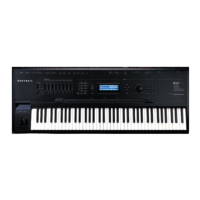Tutorials: Setup Mode
Basics Of Using Riffs
13-51
8. Next, press the RIFF2 soft button at the bottom of the display to move to the RIFF2 page once
again. On the RIFF2 page, We can see that the bass riff on zone 2 is set to sync with the first riff,
arpeggiator, or song available, because the SyncZone parameter is set to First Avail. The riff waits
to trigger until the next down beat of whatever it is syncing with because the SyncType parameter
is set to DownBeat (see below.) This is why the riff waits for a downbeat before transposing and
restarting its loop when triggered.
If you would rather not be tied to down beats for syncing this riff, you can set the SyncType to
None. With SyncType set to None, the riff will not sync to anything, which allows you to trigger
it more freely. This can be helpful if you need to transpose the riff more quickly to match chord
changes. If you would like to transpose the riff quickly, but still want it to be able to sync with
other things, a SyncType setting of AnyBeat will sync the riff at the next available beat, instead
of waiting for a down beat.
Another sync option is to have the bass riff sync only when the drum riff on zone 1 is playing.
For example, set the SyncType parameter for zone 2 to AnyBeat, and set the SyncZone
parameter to Riff 1. Press pad 1 to trigger the drum riff, and notice that the bass riff syncs with
the next beat of the drum riff when the drum riff is playing. If you press pad 1 again to stop the
drum riff, you will be able to trigger the bass riff out of sync once again.
You may also want to assign a pad to stop the bass riff, instead of using the front panel Stop
button which stops all riffs. Press the CTRLS button to go to the Controllers page for zone 2.
With the Controller field selected, hold the category Enter button and press pad 3 to select
Drum Pad 3 for the Controller field. This pad is already assigned to trigger the bass riff, but
since we can trigger it from the keyboard, lets change this pad’s assignment to stop the bass riff.
Use the cursor buttons to select the Type field and use the - /+ buttons to select Switch. With
Switch selected for the Type field, set the DestType field to Ctrl and the SW Type field to
Momentary. Finally, use the cursor buttons to select the OnControl field, then use the
alphanumeric pad to enter 164 followed by the category Enter button to select RiffOff for the
OnControl field. Do the same to select RiffOff for the OffControl field. The other fields should
be left at their default values: OnValue: 0, OffValue: 0, EntryState: Off, ExitState: Off. Now,
when you trigger the bass riff from the keyboard, you can stop the riff by pressing pad 3 (though
it will still follow any RelSynZn and RelSynTyp settings made on the RIFF2 page.)
9. To finish, press the Exit button to the right of the display to exit the Setup Editor and save your
changes to this setup under a new ID# if desired. See The Setup Editor section at the beginning
of this chapter for details on saving when you exit the Setup Editor.

